Report: Leadership and Management for Service Industries Analysis
VerifiedAdded on 2020/10/22
|8
|2012
|449
Report
AI Summary
This report examines leadership and management practices within the service industry, focusing on the application of classical management theories such as scientific and bureaucratic management in the context of restaurant chains Hazev, Haz, and Tas. It explores the roles of leaders, detailing various leadership styles including authoritarian, consensual, and hands-off approaches, and analyzes the influence of internal and external factors, such as political, economic, social, technological, legal, and environmental aspects, on management styles. The report also reviews the management and leadership styles adopted by the restaurant chains and concludes by emphasizing the importance of adapting business practices and organizational structures to maintain sustainability in a competitive market. The report highlights the importance of effective leadership and management in the service industry for success.
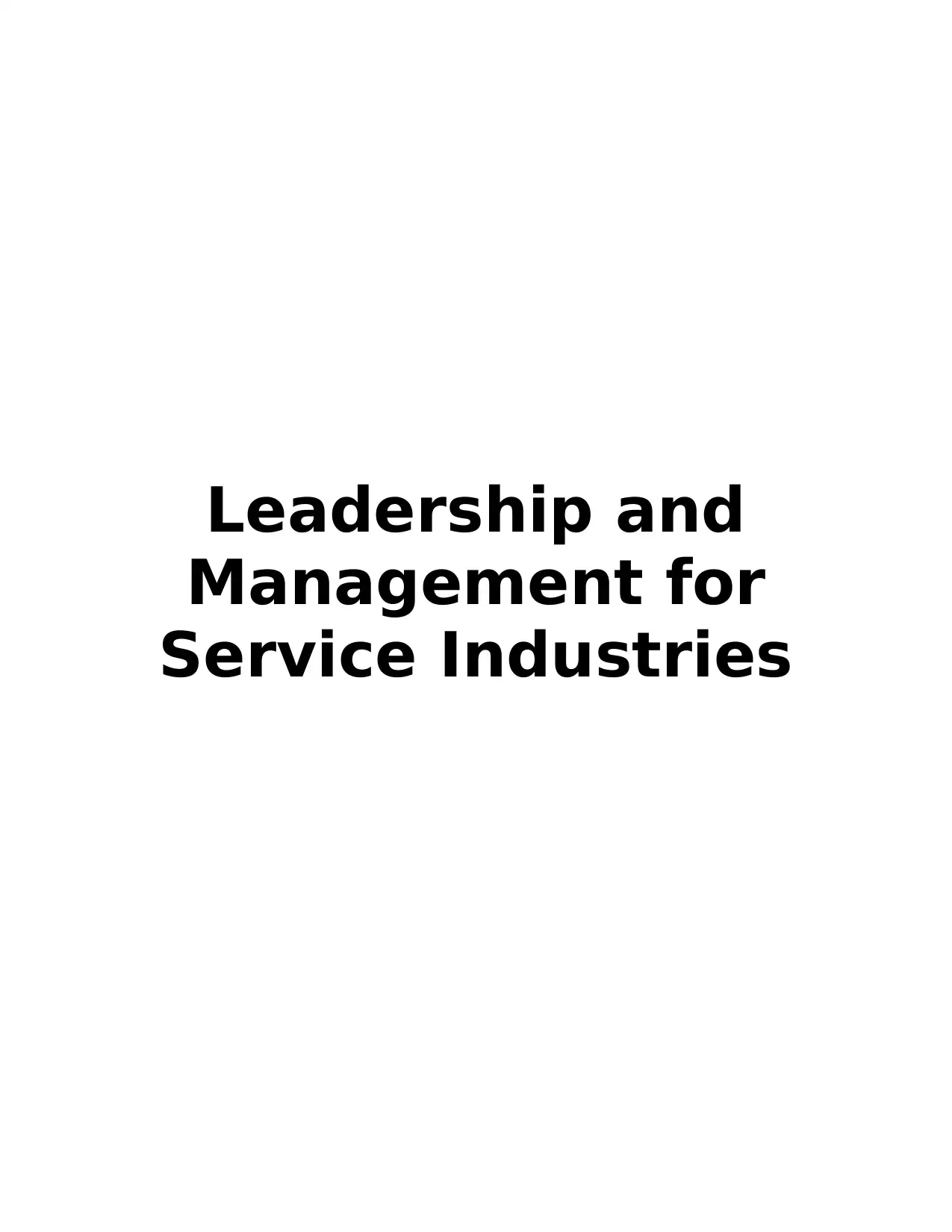
Leadership and
Management for
Service Industries
Management for
Service Industries
Paraphrase This Document
Need a fresh take? Get an instant paraphrase of this document with our AI Paraphraser

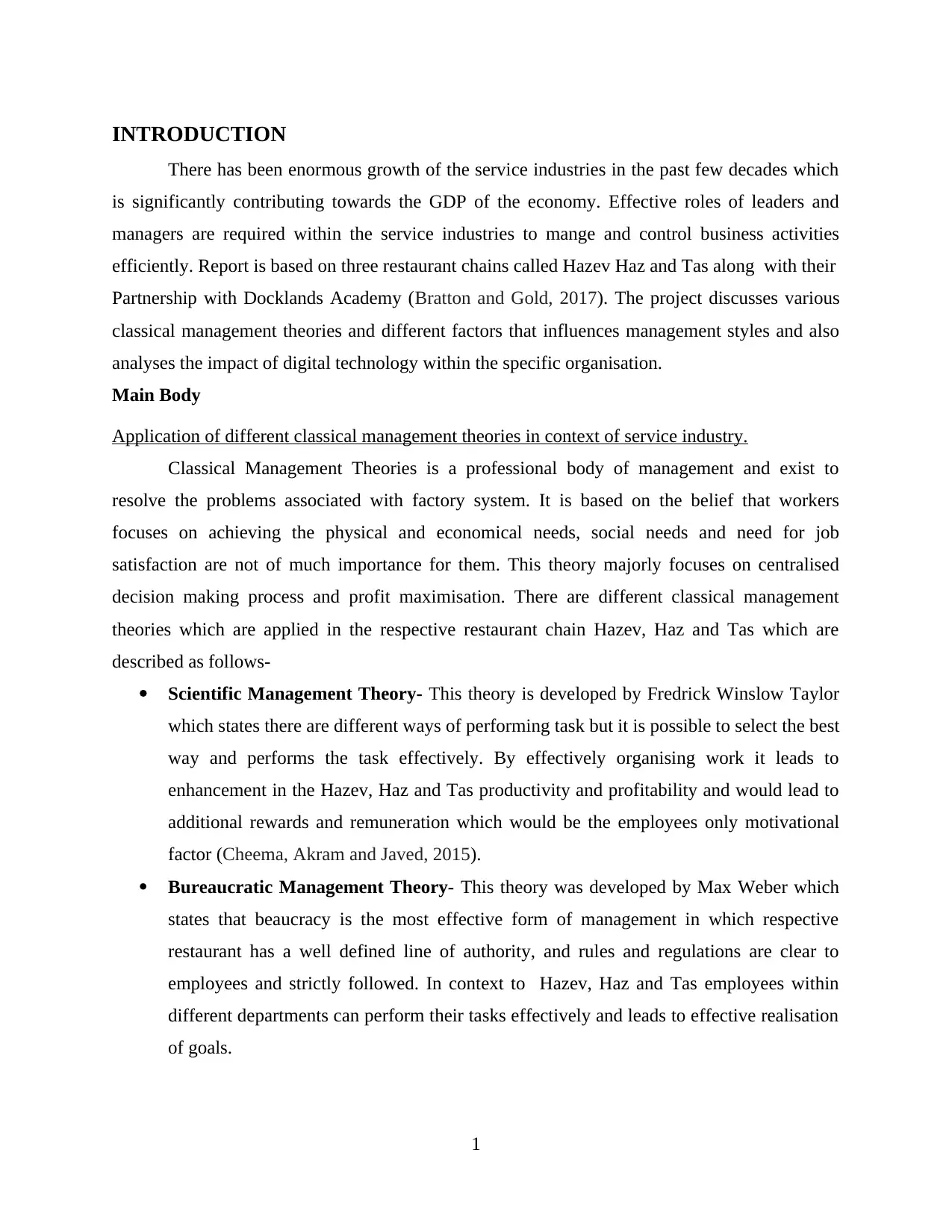
INTRODUCTION
There has been enormous growth of the service industries in the past few decades which
is significantly contributing towards the GDP of the economy. Effective roles of leaders and
managers are required within the service industries to mange and control business activities
efficiently. Report is based on three restaurant chains called Hazev Haz and Tas along with their
Partnership with Docklands Academy (Bratton and Gold, 2017). The project discusses various
classical management theories and different factors that influences management styles and also
analyses the impact of digital technology within the specific organisation.
Main Body
Application of different classical management theories in context of service industry.
Classical Management Theories is a professional body of management and exist to
resolve the problems associated with factory system. It is based on the belief that workers
focuses on achieving the physical and economical needs, social needs and need for job
satisfaction are not of much importance for them. This theory majorly focuses on centralised
decision making process and profit maximisation. There are different classical management
theories which are applied in the respective restaurant chain Hazev, Haz and Tas which are
described as follows-
Scientific Management Theory- This theory is developed by Fredrick Winslow Taylor
which states there are different ways of performing task but it is possible to select the best
way and performs the task effectively. By effectively organising work it leads to
enhancement in the Hazev, Haz and Tas productivity and profitability and would lead to
additional rewards and remuneration which would be the employees only motivational
factor (Cheema, Akram and Javed, 2015).
Bureaucratic Management Theory- This theory was developed by Max Weber which
states that beaucracy is the most effective form of management in which respective
restaurant has a well defined line of authority, and rules and regulations are clear to
employees and strictly followed. In context to Hazev, Haz and Tas employees within
different departments can perform their tasks effectively and leads to effective realisation
of goals.
1
There has been enormous growth of the service industries in the past few decades which
is significantly contributing towards the GDP of the economy. Effective roles of leaders and
managers are required within the service industries to mange and control business activities
efficiently. Report is based on three restaurant chains called Hazev Haz and Tas along with their
Partnership with Docklands Academy (Bratton and Gold, 2017). The project discusses various
classical management theories and different factors that influences management styles and also
analyses the impact of digital technology within the specific organisation.
Main Body
Application of different classical management theories in context of service industry.
Classical Management Theories is a professional body of management and exist to
resolve the problems associated with factory system. It is based on the belief that workers
focuses on achieving the physical and economical needs, social needs and need for job
satisfaction are not of much importance for them. This theory majorly focuses on centralised
decision making process and profit maximisation. There are different classical management
theories which are applied in the respective restaurant chain Hazev, Haz and Tas which are
described as follows-
Scientific Management Theory- This theory is developed by Fredrick Winslow Taylor
which states there are different ways of performing task but it is possible to select the best
way and performs the task effectively. By effectively organising work it leads to
enhancement in the Hazev, Haz and Tas productivity and profitability and would lead to
additional rewards and remuneration which would be the employees only motivational
factor (Cheema, Akram and Javed, 2015).
Bureaucratic Management Theory- This theory was developed by Max Weber which
states that beaucracy is the most effective form of management in which respective
restaurant has a well defined line of authority, and rules and regulations are clear to
employees and strictly followed. In context to Hazev, Haz and Tas employees within
different departments can perform their tasks effectively and leads to effective realisation
of goals.
1
⊘ This is a preview!⊘
Do you want full access?
Subscribe today to unlock all pages.

Trusted by 1+ million students worldwide
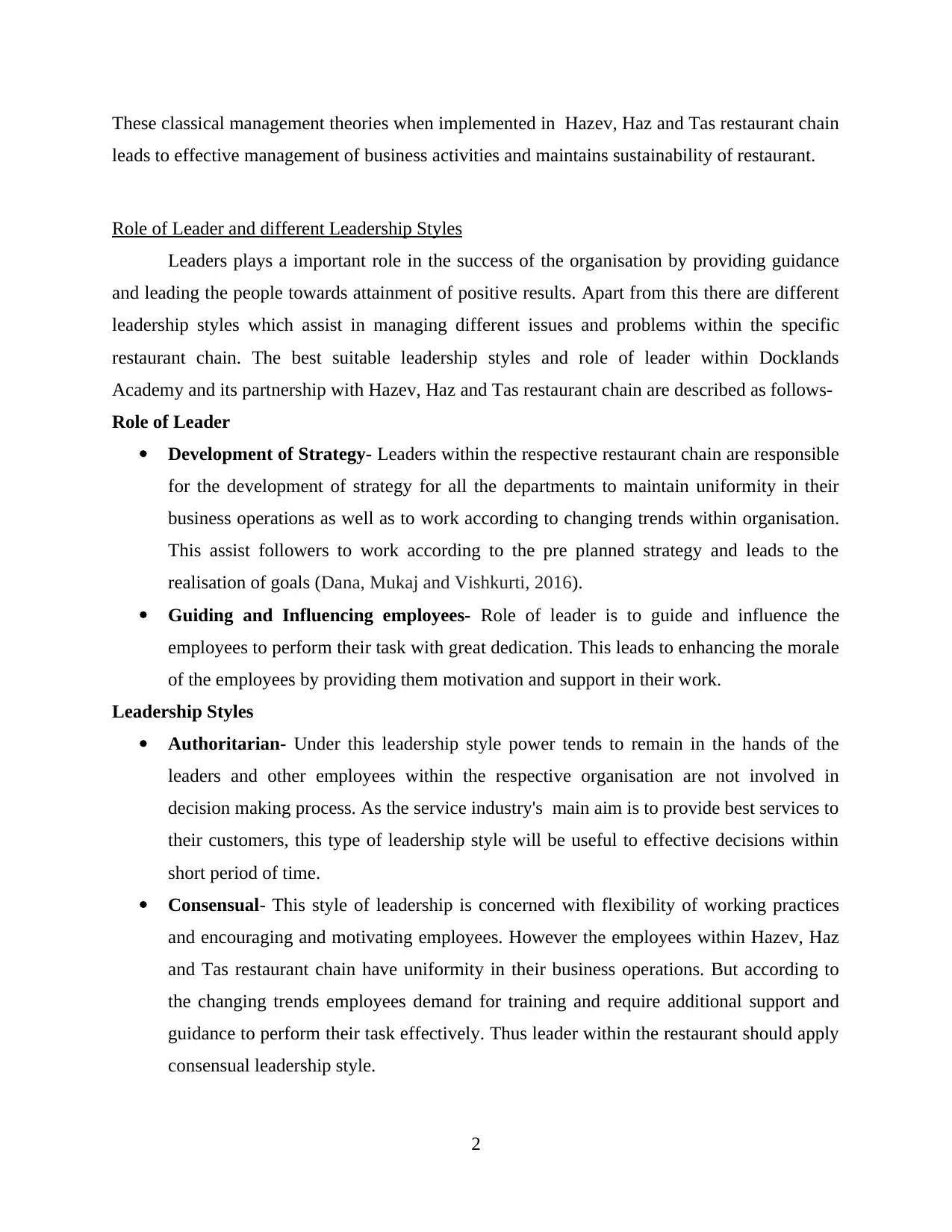
These classical management theories when implemented in Hazev, Haz and Tas restaurant chain
leads to effective management of business activities and maintains sustainability of restaurant.
Role of Leader and different Leadership Styles
Leaders plays a important role in the success of the organisation by providing guidance
and leading the people towards attainment of positive results. Apart from this there are different
leadership styles which assist in managing different issues and problems within the specific
restaurant chain. The best suitable leadership styles and role of leader within Docklands
Academy and its partnership with Hazev, Haz and Tas restaurant chain are described as follows-
Role of Leader
Development of Strategy- Leaders within the respective restaurant chain are responsible
for the development of strategy for all the departments to maintain uniformity in their
business operations as well as to work according to changing trends within organisation.
This assist followers to work according to the pre planned strategy and leads to the
realisation of goals (Dana, Mukaj and Vishkurti, 2016).
Guiding and Influencing employees- Role of leader is to guide and influence the
employees to perform their task with great dedication. This leads to enhancing the morale
of the employees by providing them motivation and support in their work.
Leadership Styles
Authoritarian- Under this leadership style power tends to remain in the hands of the
leaders and other employees within the respective organisation are not involved in
decision making process. As the service industry's main aim is to provide best services to
their customers, this type of leadership style will be useful to effective decisions within
short period of time.
Consensual- This style of leadership is concerned with flexibility of working practices
and encouraging and motivating employees. However the employees within Hazev, Haz
and Tas restaurant chain have uniformity in their business operations. But according to
the changing trends employees demand for training and require additional support and
guidance to perform their task effectively. Thus leader within the restaurant should apply
consensual leadership style.
2
leads to effective management of business activities and maintains sustainability of restaurant.
Role of Leader and different Leadership Styles
Leaders plays a important role in the success of the organisation by providing guidance
and leading the people towards attainment of positive results. Apart from this there are different
leadership styles which assist in managing different issues and problems within the specific
restaurant chain. The best suitable leadership styles and role of leader within Docklands
Academy and its partnership with Hazev, Haz and Tas restaurant chain are described as follows-
Role of Leader
Development of Strategy- Leaders within the respective restaurant chain are responsible
for the development of strategy for all the departments to maintain uniformity in their
business operations as well as to work according to changing trends within organisation.
This assist followers to work according to the pre planned strategy and leads to the
realisation of goals (Dana, Mukaj and Vishkurti, 2016).
Guiding and Influencing employees- Role of leader is to guide and influence the
employees to perform their task with great dedication. This leads to enhancing the morale
of the employees by providing them motivation and support in their work.
Leadership Styles
Authoritarian- Under this leadership style power tends to remain in the hands of the
leaders and other employees within the respective organisation are not involved in
decision making process. As the service industry's main aim is to provide best services to
their customers, this type of leadership style will be useful to effective decisions within
short period of time.
Consensual- This style of leadership is concerned with flexibility of working practices
and encouraging and motivating employees. However the employees within Hazev, Haz
and Tas restaurant chain have uniformity in their business operations. But according to
the changing trends employees demand for training and require additional support and
guidance to perform their task effectively. Thus leader within the restaurant should apply
consensual leadership style.
2
Paraphrase This Document
Need a fresh take? Get an instant paraphrase of this document with our AI Paraphraser
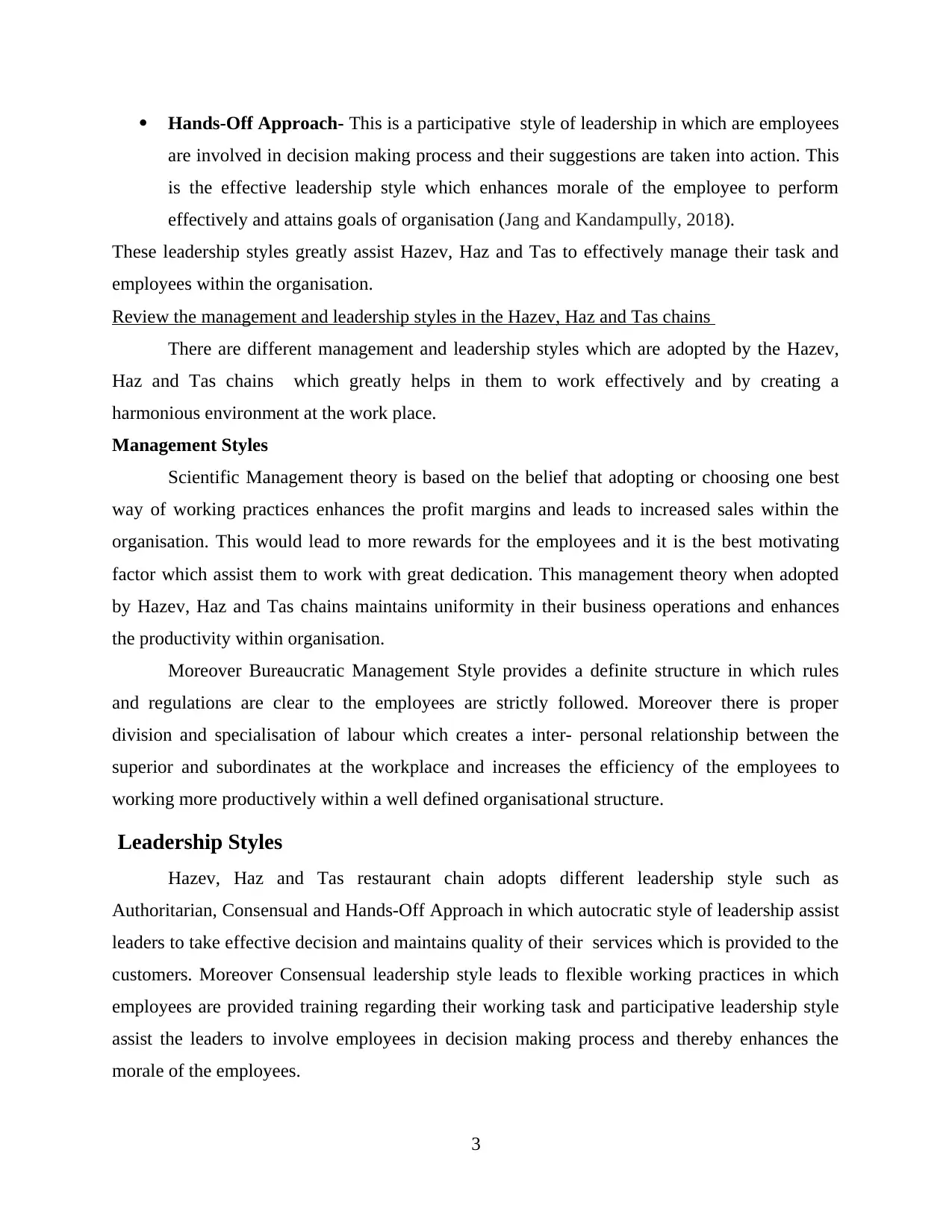
Hands-Off Approach- This is a participative style of leadership in which are employees
are involved in decision making process and their suggestions are taken into action. This
is the effective leadership style which enhances morale of the employee to perform
effectively and attains goals of organisation (Jang and Kandampully, 2018).
These leadership styles greatly assist Hazev, Haz and Tas to effectively manage their task and
employees within the organisation.
Review the management and leadership styles in the Hazev, Haz and Tas chains
There are different management and leadership styles which are adopted by the Hazev,
Haz and Tas chains which greatly helps in them to work effectively and by creating a
harmonious environment at the work place.
Management Styles
Scientific Management theory is based on the belief that adopting or choosing one best
way of working practices enhances the profit margins and leads to increased sales within the
organisation. This would lead to more rewards for the employees and it is the best motivating
factor which assist them to work with great dedication. This management theory when adopted
by Hazev, Haz and Tas chains maintains uniformity in their business operations and enhances
the productivity within organisation.
Moreover Bureaucratic Management Style provides a definite structure in which rules
and regulations are clear to the employees are strictly followed. Moreover there is proper
division and specialisation of labour which creates a inter- personal relationship between the
superior and subordinates at the workplace and increases the efficiency of the employees to
working more productively within a well defined organisational structure.
Leadership Styles
Hazev, Haz and Tas restaurant chain adopts different leadership style such as
Authoritarian, Consensual and Hands-Off Approach in which autocratic style of leadership assist
leaders to take effective decision and maintains quality of their services which is provided to the
customers. Moreover Consensual leadership style leads to flexible working practices in which
employees are provided training regarding their working task and participative leadership style
assist the leaders to involve employees in decision making process and thereby enhances the
morale of the employees.
3
are involved in decision making process and their suggestions are taken into action. This
is the effective leadership style which enhances morale of the employee to perform
effectively and attains goals of organisation (Jang and Kandampully, 2018).
These leadership styles greatly assist Hazev, Haz and Tas to effectively manage their task and
employees within the organisation.
Review the management and leadership styles in the Hazev, Haz and Tas chains
There are different management and leadership styles which are adopted by the Hazev,
Haz and Tas chains which greatly helps in them to work effectively and by creating a
harmonious environment at the work place.
Management Styles
Scientific Management theory is based on the belief that adopting or choosing one best
way of working practices enhances the profit margins and leads to increased sales within the
organisation. This would lead to more rewards for the employees and it is the best motivating
factor which assist them to work with great dedication. This management theory when adopted
by Hazev, Haz and Tas chains maintains uniformity in their business operations and enhances
the productivity within organisation.
Moreover Bureaucratic Management Style provides a definite structure in which rules
and regulations are clear to the employees are strictly followed. Moreover there is proper
division and specialisation of labour which creates a inter- personal relationship between the
superior and subordinates at the workplace and increases the efficiency of the employees to
working more productively within a well defined organisational structure.
Leadership Styles
Hazev, Haz and Tas restaurant chain adopts different leadership style such as
Authoritarian, Consensual and Hands-Off Approach in which autocratic style of leadership assist
leaders to take effective decision and maintains quality of their services which is provided to the
customers. Moreover Consensual leadership style leads to flexible working practices in which
employees are provided training regarding their working task and participative leadership style
assist the leaders to involve employees in decision making process and thereby enhances the
morale of the employees.
3
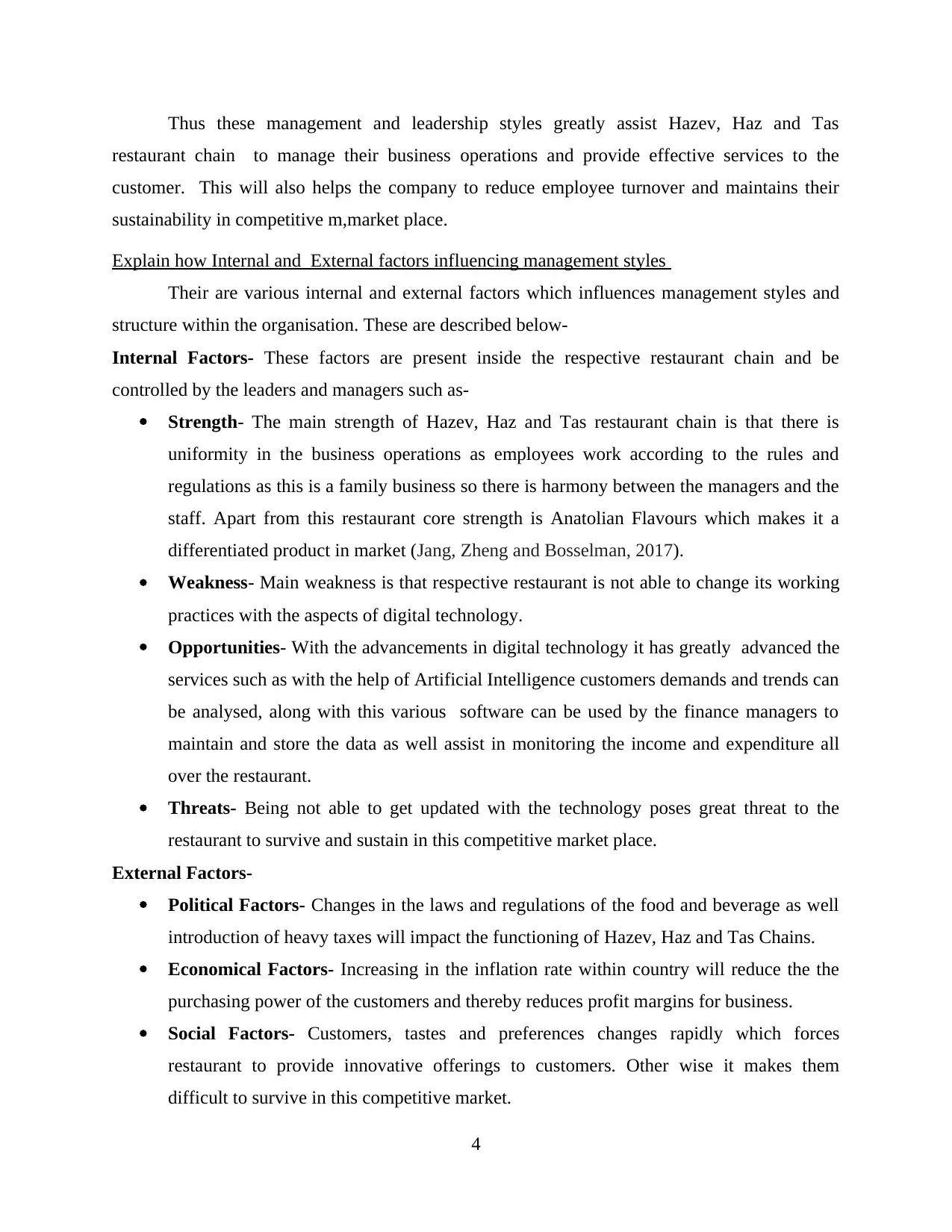
Thus these management and leadership styles greatly assist Hazev, Haz and Tas
restaurant chain to manage their business operations and provide effective services to the
customer. This will also helps the company to reduce employee turnover and maintains their
sustainability in competitive m,market place.
Explain how Internal and External factors influencing management styles
Their are various internal and external factors which influences management styles and
structure within the organisation. These are described below-
Internal Factors- These factors are present inside the respective restaurant chain and be
controlled by the leaders and managers such as-
Strength- The main strength of Hazev, Haz and Tas restaurant chain is that there is
uniformity in the business operations as employees work according to the rules and
regulations as this is a family business so there is harmony between the managers and the
staff. Apart from this restaurant core strength is Anatolian Flavours which makes it a
differentiated product in market (Jang, Zheng and Bosselman, 2017).
Weakness- Main weakness is that respective restaurant is not able to change its working
practices with the aspects of digital technology.
Opportunities- With the advancements in digital technology it has greatly advanced the
services such as with the help of Artificial Intelligence customers demands and trends can
be analysed, along with this various software can be used by the finance managers to
maintain and store the data as well assist in monitoring the income and expenditure all
over the restaurant.
Threats- Being not able to get updated with the technology poses great threat to the
restaurant to survive and sustain in this competitive market place.
External Factors-
Political Factors- Changes in the laws and regulations of the food and beverage as well
introduction of heavy taxes will impact the functioning of Hazev, Haz and Tas Chains.
Economical Factors- Increasing in the inflation rate within country will reduce the the
purchasing power of the customers and thereby reduces profit margins for business.
Social Factors- Customers, tastes and preferences changes rapidly which forces
restaurant to provide innovative offerings to customers. Other wise it makes them
difficult to survive in this competitive market.
4
restaurant chain to manage their business operations and provide effective services to the
customer. This will also helps the company to reduce employee turnover and maintains their
sustainability in competitive m,market place.
Explain how Internal and External factors influencing management styles
Their are various internal and external factors which influences management styles and
structure within the organisation. These are described below-
Internal Factors- These factors are present inside the respective restaurant chain and be
controlled by the leaders and managers such as-
Strength- The main strength of Hazev, Haz and Tas restaurant chain is that there is
uniformity in the business operations as employees work according to the rules and
regulations as this is a family business so there is harmony between the managers and the
staff. Apart from this restaurant core strength is Anatolian Flavours which makes it a
differentiated product in market (Jang, Zheng and Bosselman, 2017).
Weakness- Main weakness is that respective restaurant is not able to change its working
practices with the aspects of digital technology.
Opportunities- With the advancements in digital technology it has greatly advanced the
services such as with the help of Artificial Intelligence customers demands and trends can
be analysed, along with this various software can be used by the finance managers to
maintain and store the data as well assist in monitoring the income and expenditure all
over the restaurant.
Threats- Being not able to get updated with the technology poses great threat to the
restaurant to survive and sustain in this competitive market place.
External Factors-
Political Factors- Changes in the laws and regulations of the food and beverage as well
introduction of heavy taxes will impact the functioning of Hazev, Haz and Tas Chains.
Economical Factors- Increasing in the inflation rate within country will reduce the the
purchasing power of the customers and thereby reduces profit margins for business.
Social Factors- Customers, tastes and preferences changes rapidly which forces
restaurant to provide innovative offerings to customers. Other wise it makes them
difficult to survive in this competitive market.
4
⊘ This is a preview!⊘
Do you want full access?
Subscribe today to unlock all pages.

Trusted by 1+ million students worldwide
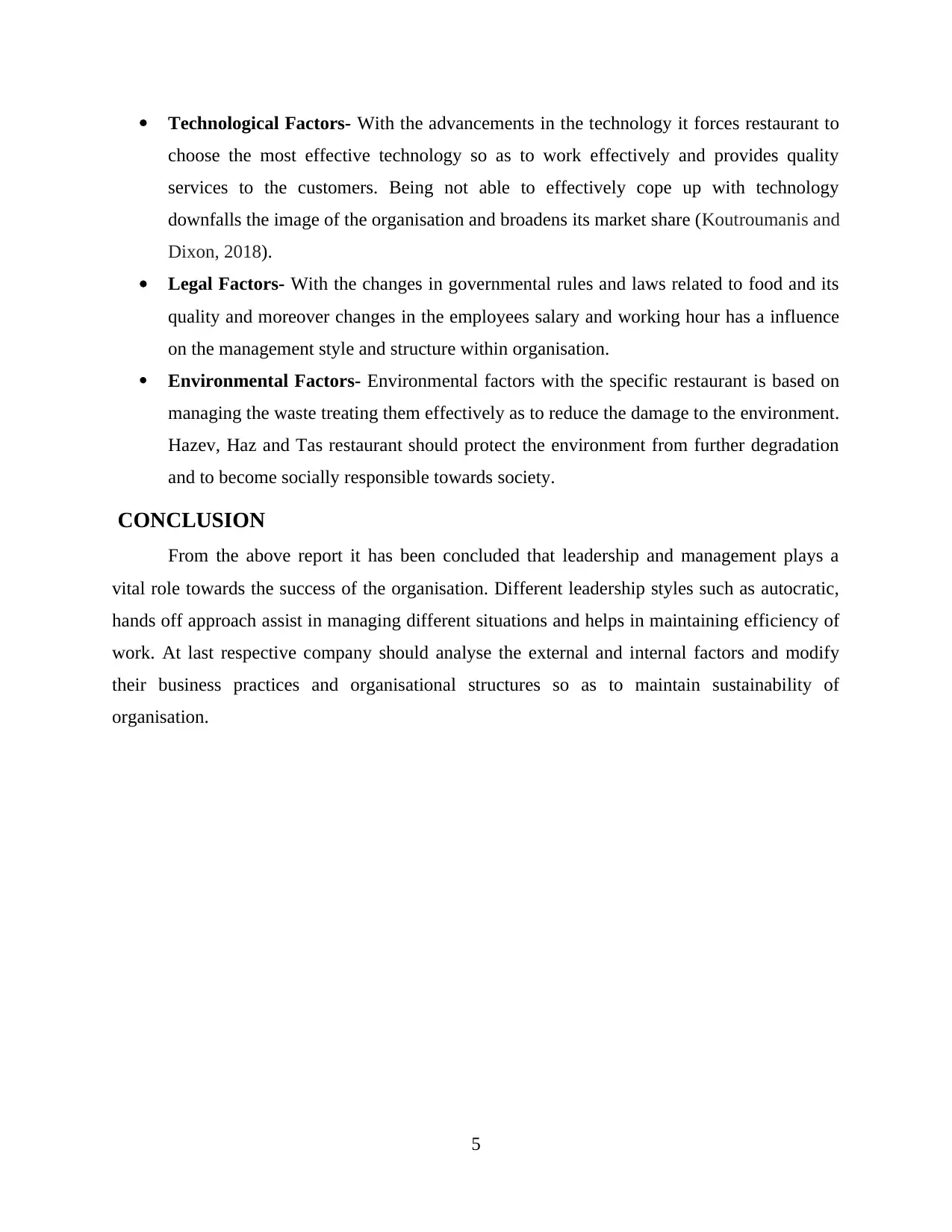
Technological Factors- With the advancements in the technology it forces restaurant to
choose the most effective technology so as to work effectively and provides quality
services to the customers. Being not able to effectively cope up with technology
downfalls the image of the organisation and broadens its market share (Koutroumanis and
Dixon, 2018).
Legal Factors- With the changes in governmental rules and laws related to food and its
quality and moreover changes in the employees salary and working hour has a influence
on the management style and structure within organisation.
Environmental Factors- Environmental factors with the specific restaurant is based on
managing the waste treating them effectively as to reduce the damage to the environment.
Hazev, Haz and Tas restaurant should protect the environment from further degradation
and to become socially responsible towards society.
CONCLUSION
From the above report it has been concluded that leadership and management plays a
vital role towards the success of the organisation. Different leadership styles such as autocratic,
hands off approach assist in managing different situations and helps in maintaining efficiency of
work. At last respective company should analyse the external and internal factors and modify
their business practices and organisational structures so as to maintain sustainability of
organisation.
5
choose the most effective technology so as to work effectively and provides quality
services to the customers. Being not able to effectively cope up with technology
downfalls the image of the organisation and broadens its market share (Koutroumanis and
Dixon, 2018).
Legal Factors- With the changes in governmental rules and laws related to food and its
quality and moreover changes in the employees salary and working hour has a influence
on the management style and structure within organisation.
Environmental Factors- Environmental factors with the specific restaurant is based on
managing the waste treating them effectively as to reduce the damage to the environment.
Hazev, Haz and Tas restaurant should protect the environment from further degradation
and to become socially responsible towards society.
CONCLUSION
From the above report it has been concluded that leadership and management plays a
vital role towards the success of the organisation. Different leadership styles such as autocratic,
hands off approach assist in managing different situations and helps in maintaining efficiency of
work. At last respective company should analyse the external and internal factors and modify
their business practices and organisational structures so as to maintain sustainability of
organisation.
5
Paraphrase This Document
Need a fresh take? Get an instant paraphrase of this document with our AI Paraphraser
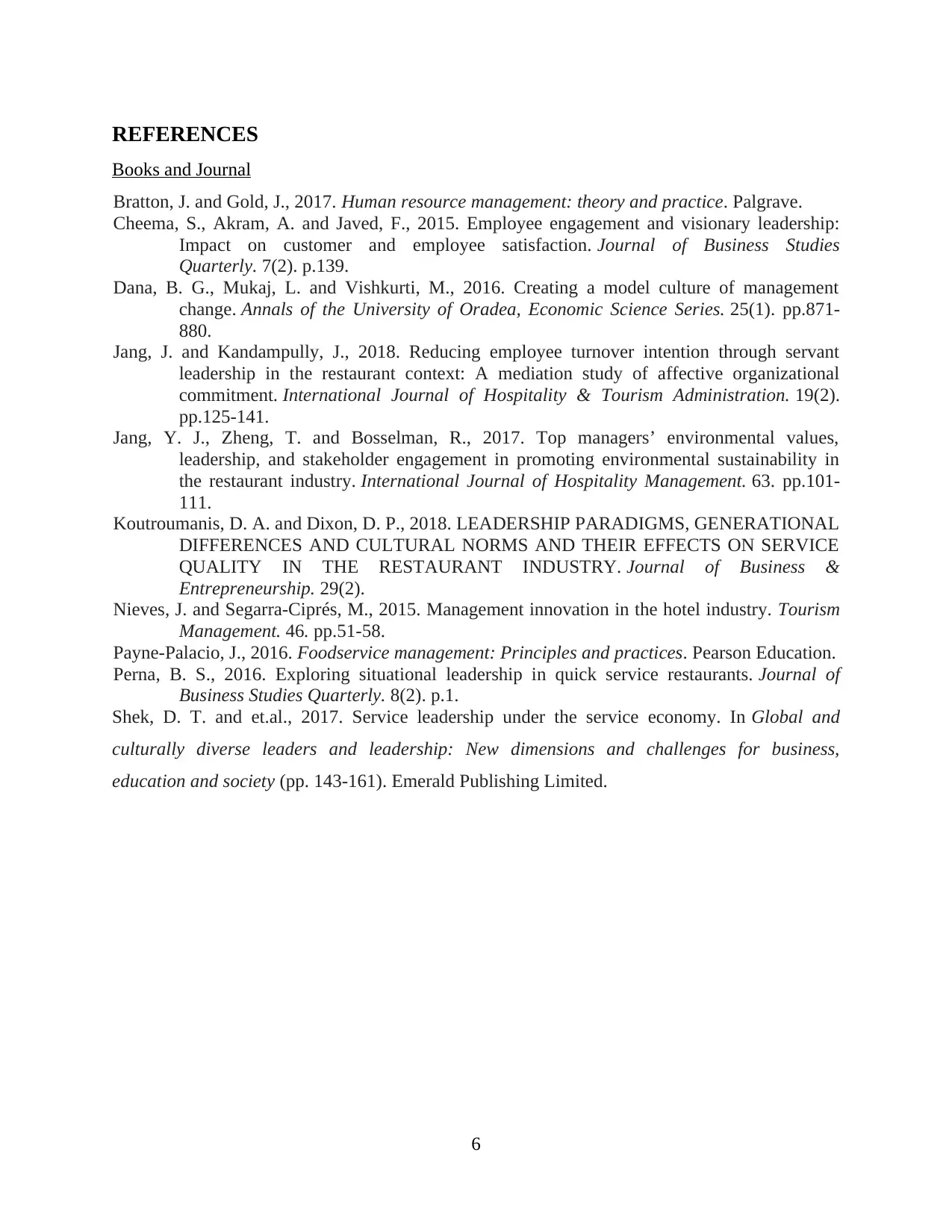
REFERENCES
Books and Journal
Bratton, J. and Gold, J., 2017. Human resource management: theory and practice. Palgrave.
Cheema, S., Akram, A. and Javed, F., 2015. Employee engagement and visionary leadership:
Impact on customer and employee satisfaction. Journal of Business Studies
Quarterly. 7(2). p.139.
Dana, B. G., Mukaj, L. and Vishkurti, M., 2016. Creating a model culture of management
change. Annals of the University of Oradea, Economic Science Series. 25(1). pp.871-
880.
Jang, J. and Kandampully, J., 2018. Reducing employee turnover intention through servant
leadership in the restaurant context: A mediation study of affective organizational
commitment. International Journal of Hospitality & Tourism Administration. 19(2).
pp.125-141.
Jang, Y. J., Zheng, T. and Bosselman, R., 2017. Top managers’ environmental values,
leadership, and stakeholder engagement in promoting environmental sustainability in
the restaurant industry. International Journal of Hospitality Management. 63. pp.101-
111.
Koutroumanis, D. A. and Dixon, D. P., 2018. LEADERSHIP PARADIGMS, GENERATIONAL
DIFFERENCES AND CULTURAL NORMS AND THEIR EFFECTS ON SERVICE
QUALITY IN THE RESTAURANT INDUSTRY. Journal of Business &
Entrepreneurship. 29(2).
Nieves, J. and Segarra-Ciprés, M., 2015. Management innovation in the hotel industry. Tourism
Management. 46. pp.51-58.
Payne-Palacio, J., 2016. Foodservice management: Principles and practices. Pearson Education.
Perna, B. S., 2016. Exploring situational leadership in quick service restaurants. Journal of
Business Studies Quarterly. 8(2). p.1.
Shek, D. T. and et.al., 2017. Service leadership under the service economy. In Global and
culturally diverse leaders and leadership: New dimensions and challenges for business,
education and society (pp. 143-161). Emerald Publishing Limited.
6
Books and Journal
Bratton, J. and Gold, J., 2017. Human resource management: theory and practice. Palgrave.
Cheema, S., Akram, A. and Javed, F., 2015. Employee engagement and visionary leadership:
Impact on customer and employee satisfaction. Journal of Business Studies
Quarterly. 7(2). p.139.
Dana, B. G., Mukaj, L. and Vishkurti, M., 2016. Creating a model culture of management
change. Annals of the University of Oradea, Economic Science Series. 25(1). pp.871-
880.
Jang, J. and Kandampully, J., 2018. Reducing employee turnover intention through servant
leadership in the restaurant context: A mediation study of affective organizational
commitment. International Journal of Hospitality & Tourism Administration. 19(2).
pp.125-141.
Jang, Y. J., Zheng, T. and Bosselman, R., 2017. Top managers’ environmental values,
leadership, and stakeholder engagement in promoting environmental sustainability in
the restaurant industry. International Journal of Hospitality Management. 63. pp.101-
111.
Koutroumanis, D. A. and Dixon, D. P., 2018. LEADERSHIP PARADIGMS, GENERATIONAL
DIFFERENCES AND CULTURAL NORMS AND THEIR EFFECTS ON SERVICE
QUALITY IN THE RESTAURANT INDUSTRY. Journal of Business &
Entrepreneurship. 29(2).
Nieves, J. and Segarra-Ciprés, M., 2015. Management innovation in the hotel industry. Tourism
Management. 46. pp.51-58.
Payne-Palacio, J., 2016. Foodservice management: Principles and practices. Pearson Education.
Perna, B. S., 2016. Exploring situational leadership in quick service restaurants. Journal of
Business Studies Quarterly. 8(2). p.1.
Shek, D. T. and et.al., 2017. Service leadership under the service economy. In Global and
culturally diverse leaders and leadership: New dimensions and challenges for business,
education and society (pp. 143-161). Emerald Publishing Limited.
6
1 out of 8
Related Documents
Your All-in-One AI-Powered Toolkit for Academic Success.
+13062052269
info@desklib.com
Available 24*7 on WhatsApp / Email
![[object Object]](/_next/static/media/star-bottom.7253800d.svg)
Unlock your academic potential
Copyright © 2020–2025 A2Z Services. All Rights Reserved. Developed and managed by ZUCOL.





